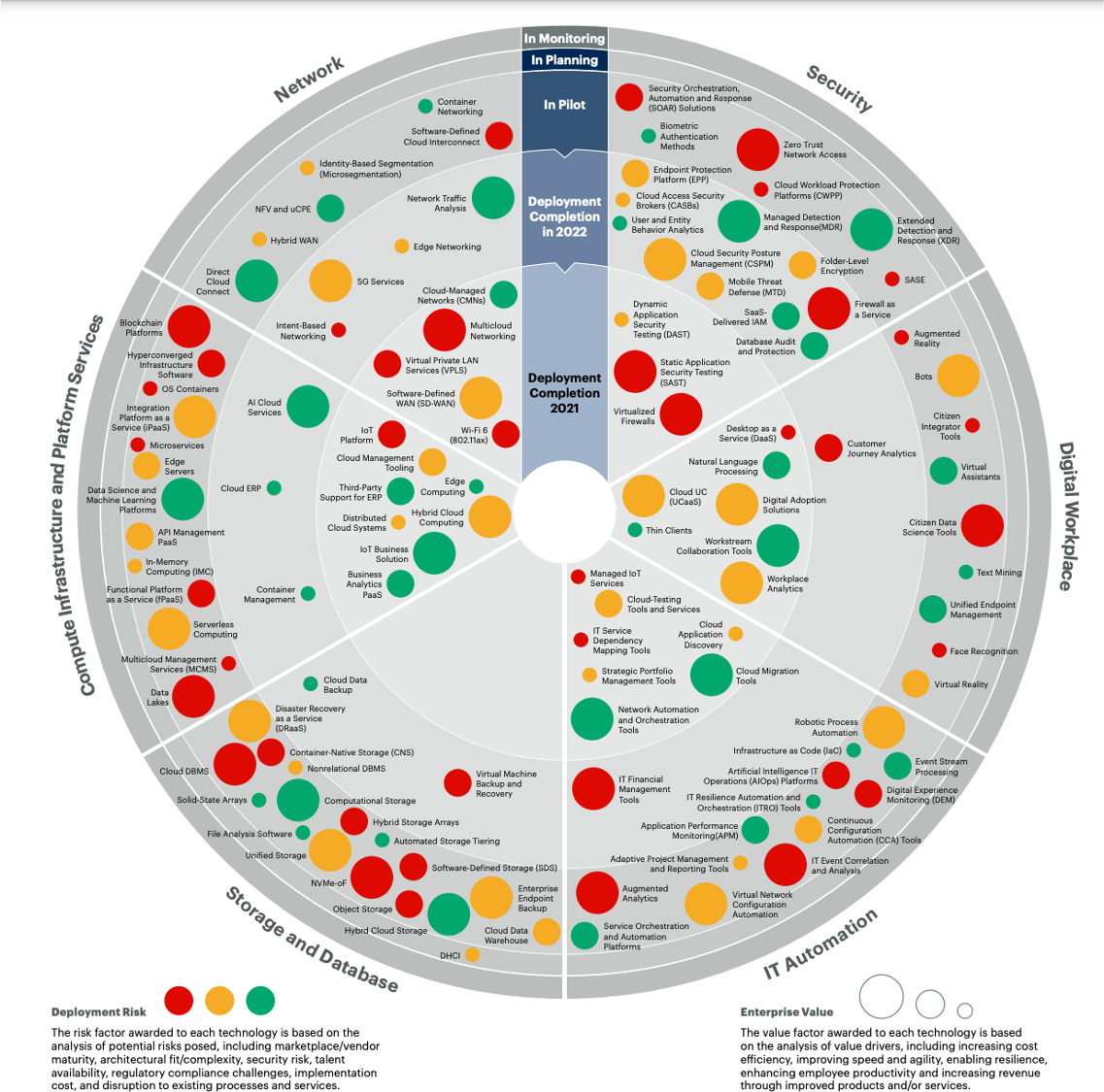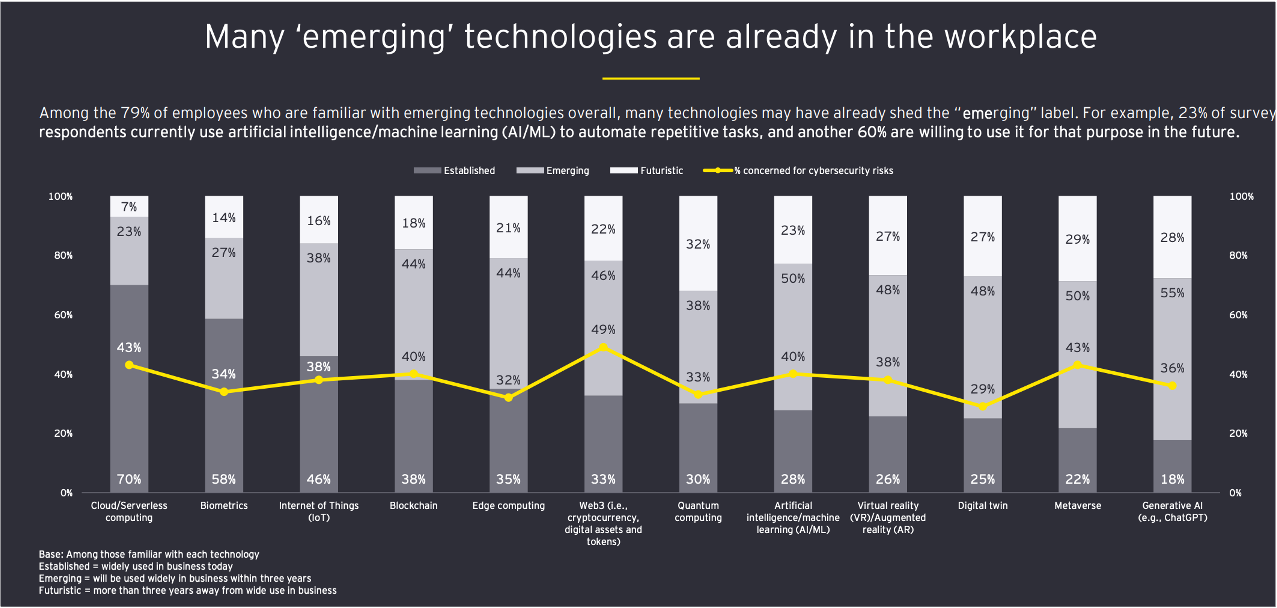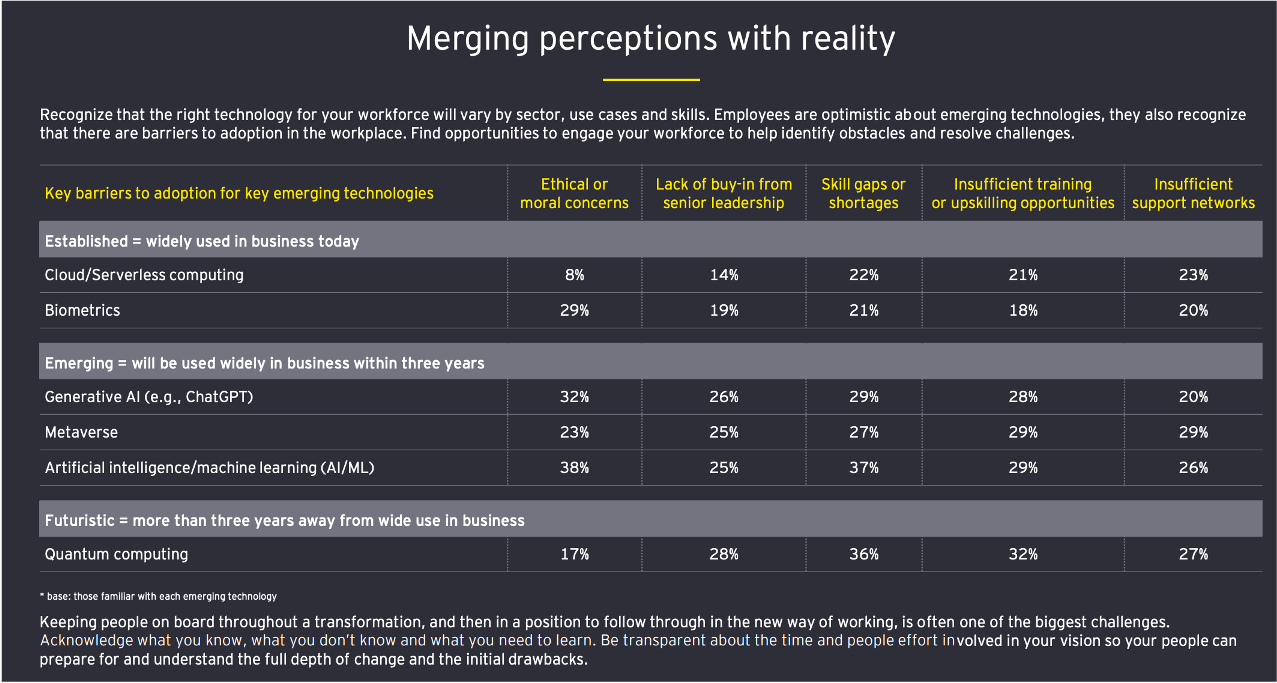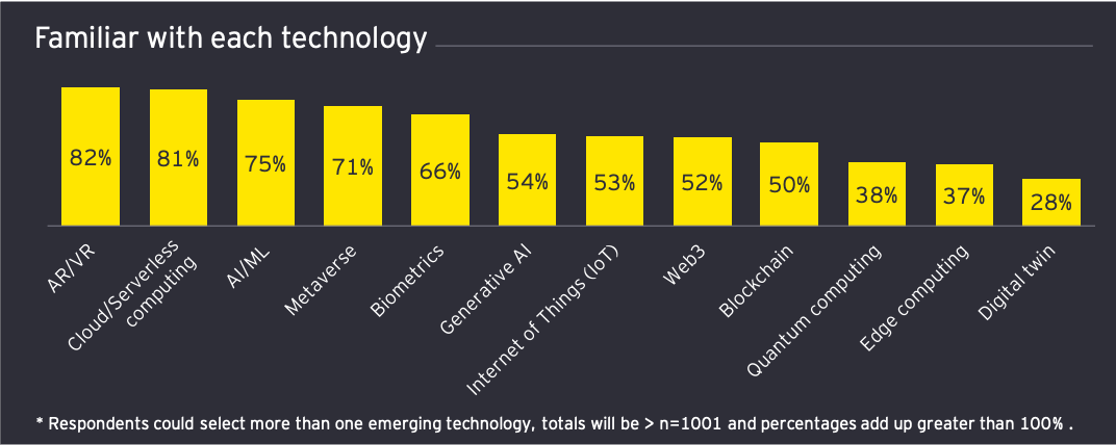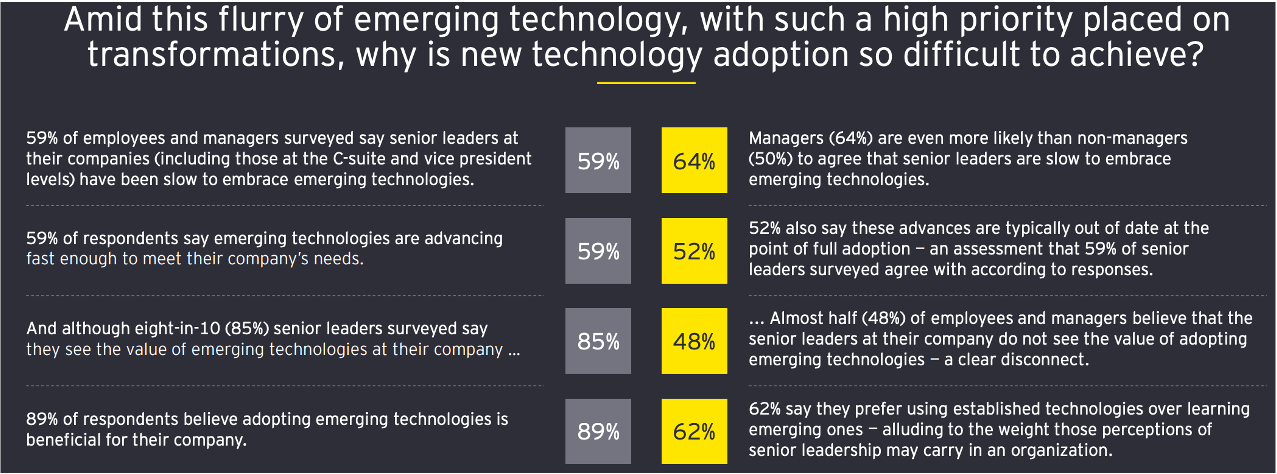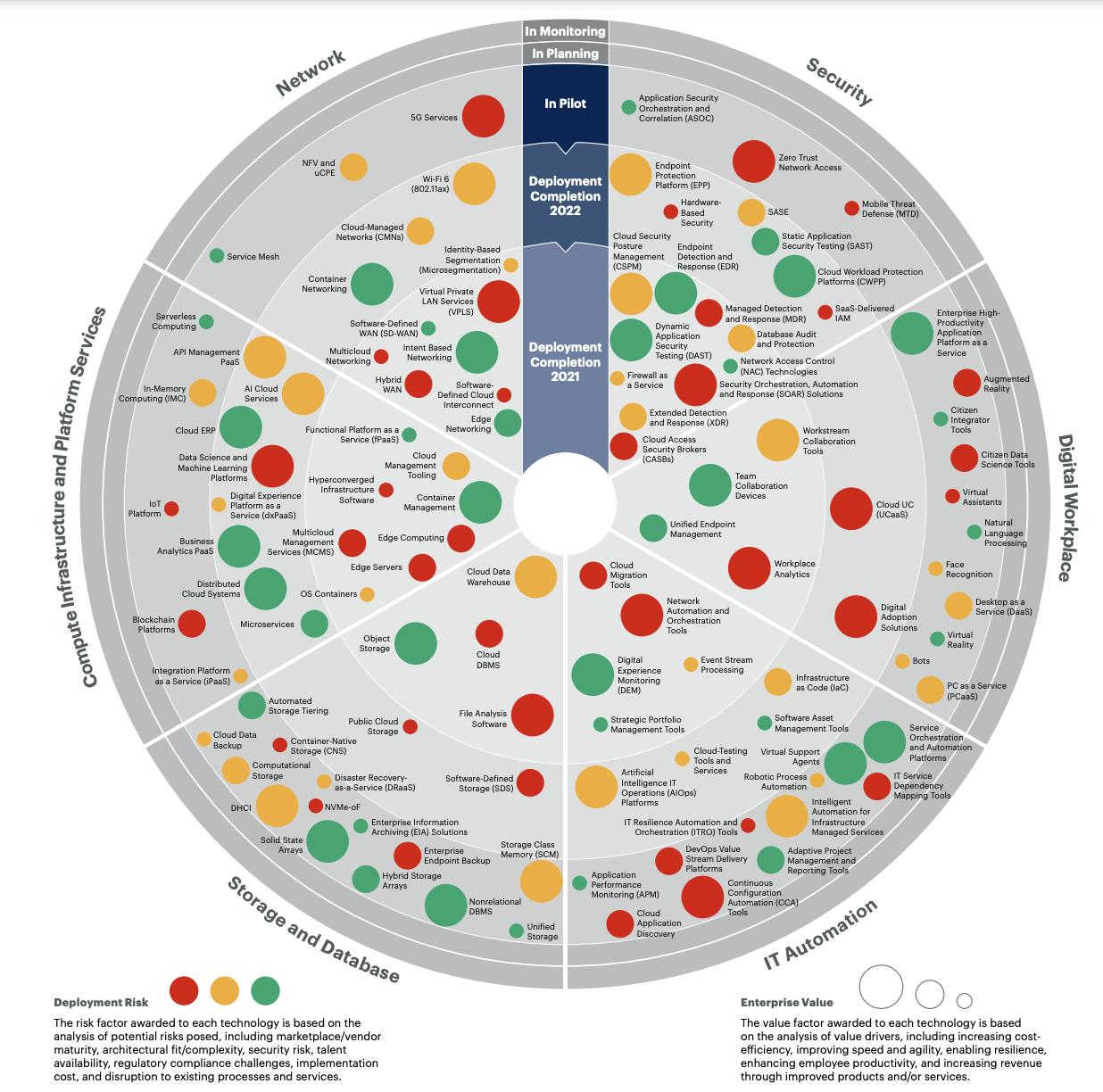Roadmap for Emerging Business Technologies
“As each wave of technology is released. It must be accompanied by a demand for new skills, new language. Consumers must constantly update their ways of thinking, always questioning their understanding of the world. Going back to old ways, old technology is forbidden. There in no past, no present, only an endless future of inadequacy.”
-- Richard Kadrey
Roadmap for Emerging Business Technologies
“As each wave of technology is released. It must be accompanied by a demand for new skills, new language. Consumers must constantly update their ways of thinking, always questioning their understanding of the world. Going back to old ways, old technology is forbidden. There is no past, no present, only an endless future of inadequacy.”
-- Richard Kadrey
Businesses can benefit from the meteoric rise of emerging technologies, such as artificial intelligence (AI) and blockchain. But to do so, companies must develop a comprehensive roadmap for their implementation. This includes assessing the current needs and capabilities of the organization and identifying any potential cultural or technological barriers to adoption. Additionally, businesses should create an actionable plan that outlines clear goals, identifies resources required, and sets realistic timelines for achieving desired results. Finally, businesses should closely monitor their progress as they make their journey toward the successful implementation of emerging technologies.
According to Gartner analyst David Groombridge, business leaders need to recognize the emerging technologies that will shape their future. Many executives are believers in innovation being a pivotal tool for upholding growth and advancing success. Therefore, having an understanding of where these developments can lead them is critical - something that trend analysis helps streamline at rapid speed. Thus, as business technologies continue to emerge and evolve, those businesses that can stay ahead of the adoption curve will have a distinct advantage over their competition.
So, to start, it is essential to categorize emerging technologies. We can group them into four main categories:
- 1) Immersive Interface,
- 2) Organizational Transformation,
- 3) Transparency and Automated Trust, and
- 4) Integration and Digital Reflections.
Disruptors (34:40)
- Experience Disruptors
- Adaptation #1: Experience-Market Fit
- Adaptation #2: Friction-less
- Adaptation #3: Personalized
- Adaptation #4: Sell Through Customers
- Adaptation #5: Business Model Busters
- Your SuperPowers
Sentiment Analysis
127 positive sentences, and 53 negative ones were identified.
----------------------------------------
Summarization
THE SECRET TO DISRUPTION
The word disruption has been heavily overused and heavily under-understood. What's so confusing about this word? And I call that species an experience disruptor.
UNDERSTANDING THE EXPERIENCE DISRUPTORS
The experience disruptors work on experience market fit. They take the cringeworthy process of buying a car, automated it, institutionalized it, and made it awesome. When I look at these Experience Disruptors, they all have great products, but they have even better experiences.
B2B EXPERIENCE DISRUPTORS: FIGHTING FRICTION
All of the B2B experience disruptors are playing this new playbook. They focus less on generating leads in, more on generating active users.
THE 3 GENETIC ADAPTATIONS OF EXPERIENCE DISRUPTORS
The incumbents when you're a prospect and a customer is relatively anonymous experience with them, the experience disruptors. Netflix isn't the only company moving away from personas and using data to be much more prescriptive about personalization. How they sell is why they win.
EXPERIENCE DISRUPTORS: WHY THEY WIN
The incumbents, well, they're very good at selling to their customers. The experienced disruptors are good at selling through customers. These disruptors rethought terms and conditions in ways that were customer friendly. They embrace unconventional wisdom.
HACKING THE EXPERIENCE DISRUPTORS
Don't obsess about product market fit. Maniacally remove friction. Sell through your customers. Rethink ye old business model.
-----------------------
https://www.assemblyai.com/playground/transcript/6saiq21m56-22b2-40d2-a2e8-216dfc727df3
Top Tech Trends (7:48)
- AI Everywhere
- Parts of the Metaverse Will Become Real
- Progress in Web3
- Bridging the Digital and Physical World
- Increasingly Editable Nature
- Quantum Progress
- Progress in Green Technology
- Robots Will Become More Human
- Progress in Autonomous System
- More Sustainable Technology
Top 10 Tech Trends, Bernard Marr & Co.: https://www.youtube.com/watch?v=ZXx-y7gut9I
The Top 5 In Demand Tech Skills For Jobs (4:47)
The job market is shifting all the time and every-faster digitization means the skills companies will require are changing. Here we look at the top in-demand skills:
- Data Communicator/ Storyteller
- Cyber Security
- UX Design
- Digital Marketing
- Augmenting work with AI
The Top 5 In Demand Tech Skills For Jobs
https://www.youtube.com/watch?v=Wgc-IqPprEs
Interaction
The technologies that power human-computer interaction get more complex, but user experiences get simpler.
Information
As our information systems continue to advance, machine intelligence itself will become increasingly well rounded.
Computation
As computers continue to miniaturize, virtualize, and decentralize, our capacity to process data, create and curate content, develop and code, and solve problems is on an unstoppable march toward abundance.
Quantum computing: going beyond bits entirely, and harnessing the quirky laws of quantum mechanics to speedily solve previously intractable problems with physics rather than mathematics.
https://www2.deloitte.com/us/en/insights/focus/tech-trends.html
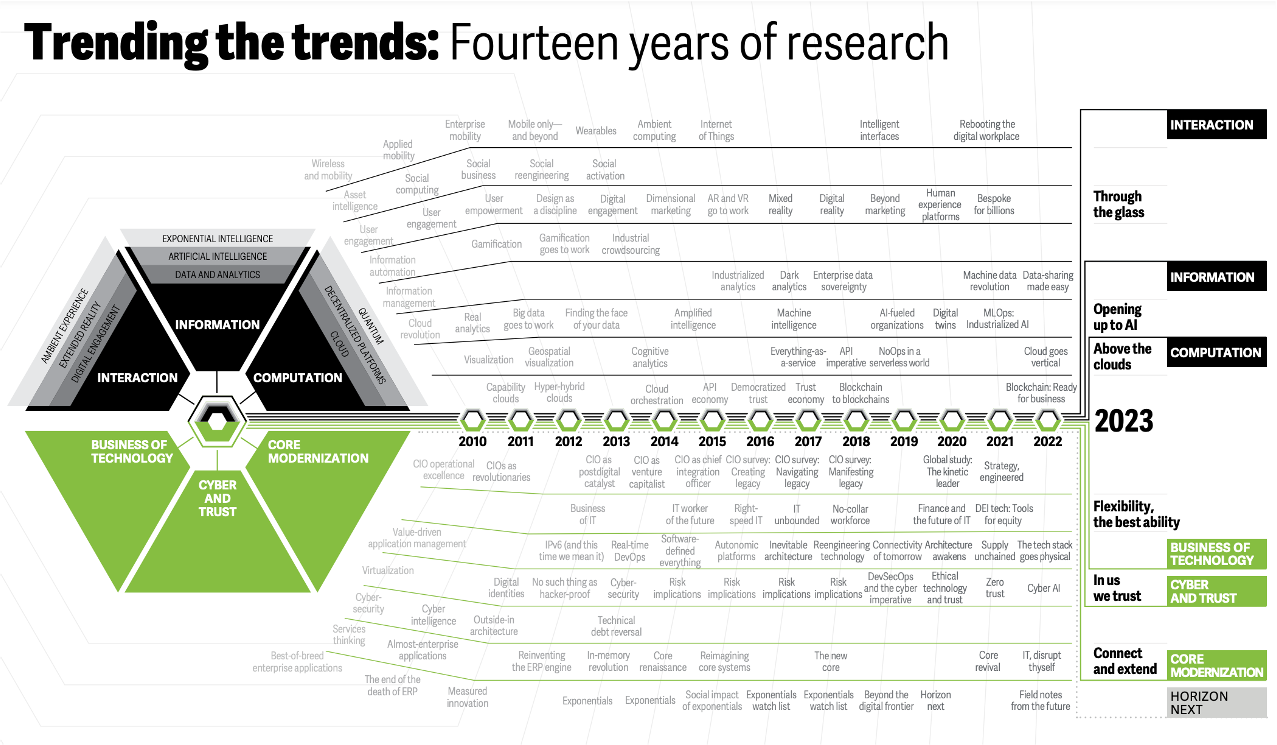
Midsize Emerging Trends Roadmap
To build a successful technology adoption strategy, CIOs and IT leaders need to understand the value and risks of emerging technologies based on their peers’ perceptions.
The Gartner Emerging Technology Roadmap benchmark helps solve challenges associated with technology deployment for midsize enterprises.
The Emerging Technology Roadmap harnesses the collective wisdom of your peers to understand deployment plans, adoption timelines, value and risks across core infrastructure domains, including compute and storage, cloud, workplace network, security and automation.
Top Management ‘Slow to Embrace’ Emerging Tech
A majority of US workers (89%) believe adopting emerging technologies is beneficial for their company, but more than half (59%) say their senior leadership is slow to embrace potentially game-changing technologies, according to new data released by Ernst & Young LLP.
The Emerging Tech at Work Survey asked more than 1,000 US employees about their familiarity with and expected impact of 12 emerging technologies — including artificial intelligence/machine learning, augmented reality/virtual reality, digital twin, edge and quantum computing, biometrics, among others — revealing crucial insights for business leaders considering the implementation of new technologies and navigating barriers to adoption.
Employees are enthusiastic about the promise of new technologies, but 52% say that technologies are outdated by the time their company does implement them. In addition, there is a generational divide in adoption and expectations.
- Gen Z and millennial employees are more likely than other generations of employees to say they currently use generative AI to draft emails
- (24% for Gen Z and 27% for millennial vs. 12% for Gen X and 6% for baby boomers) and
- Gen Z and millennial employees are also more likely to say senior leadership at their company do not see the value of adopting emerging technology
- (58% for Gen Z and 53% for millennial vs. 42% for Gen X and 42% for baby boomers).
“Today’s workforce is anxiously awaiting tomorrow’s digital capabilities. Though leaders acknowledge how new technologies can transform their business, they need to also be aware of employee perceptions around the slow pace of adoption, and the barriers and risks that could undermine efforts.”
What is Computational Storage? (9:45)
Computational storage is the use of computing resources to store data, usually in addition to, or instead of, traditional storage methods.
It enables a new way of managing and using data by combining powerful data-processing capabilities with large-scale storage.
Computational storage allows for more efficient use of resources by allowing computers to process data directly from the storage device, rather than having to make multiple requests to separate storage and computing devices. This reduces latency and improves performance overall.
Quantum State of the Union 2022 (54:32)
Topics:
- Error Mitigation
- Dynamic Circuits
- Middleware for Quantum
- Evolution of the Quantum Stack
-------------------------------------------------------
IBM Quantum Summit 2022 — What’s New: https://www.ibm.com/quantum/summit
--------------------------------------------------------
Sentiment Analysis:
The overall sentiment of the conversation is positive and optimistic. However, they could have better achieved their objectives by providing more details on how they will overcome the challenges to achieve the 100 by 100 goal and a quantum advantage. More specifics on their plans and roadmaps would instill greater confidence.
Summarization:
Welcome to the IBM Quantum Summit. Quantum computers can help solve hard problems like climate change. IBM's new 433-qubit quantum chip and how much faster and better their quantum computers have gotten.
IBM announced that quantum software can now fix more errors. Users can choose how much they want to fix errors to balance cost and accuracy. IBM's quantum software now works on 18 of their quantum computers.
IBM is helping more people learn about quantum computing. More scientists are using quantum computers and working with IBM. To use quantum computers, people need access to real quantum computers, software, and training. IBM now charges for some of their quantum software and helps companies get started with quantum computing.
There is a need to protect information from future powerful quantum computers. IBM has been working on new ways to encrypt data that quantum computers can't break. The U.S. government and phone companies are starting to use these new encryption methods. IBM is also helping companies switch to encryption that quantum computers can't crack.
IBM's quantum work and community have been growing fast. IBM's new 1,000-qubit quantum processor is called Condor. IBM has new tools to make quantum circuits bigger.
IBM designs their quantum computers in modules. IBM's quantum software that will make quantum computers more useful. The design of IBM's next quantum computer was highlighted. Finally, IBM challenged itself to build a quantum computer with 100 qubits that can run 100 operations by 2024.
Enterprise Emerging Trends Roadmap
“Enterprises are recognizing that they are no longer the employer of choice and that more IT will have to be done by external resources."
- John-David Lovelock, Vice President at Gartner
To build a successful technology adoption strategy, CIOs and IT leaders need to understand the value and risks of emerging technologies based on their peers’ perceptions.
The Gartner Emerging Technology Roadmap benchmark helps solve challenges associated with technology deployment for large enterprises.
The Emerging Technology Roadmap harnesses the collective wisdom of your peers to understand deployment plans, adoption timelines, value and risks across core infrastructure domains, including compute and storage, cloud, workplace network, security and automation.

